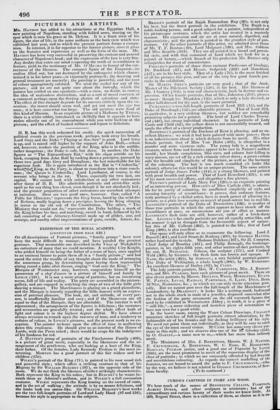CURIOUS CARVINGS IN IVORY AND WOOD.
WE hear much of the names of BENVENUTO CELLINI, PIAMINGOr ALBERT BORER, and other sculptors in miniature; but of the extraordinary and curious beauty of their works we know little. At 209, Regent Street, there is a collection of them, as choice as it is ex- tensive, which has occupied some seventeen years of the life of a con- noisseur, Mr. HERTZ, to get together from all parts of the Continent. Here the amateur may gratify his curiosity and his taste more effect- ually than by a tour in search of objects of viral. There are specimens of all kinds of the ingenuity and patient skill with which the artists of old elaborated their works. • Cups of ivory, consisting of masses of figures, exquisitely carved in Las relit/'; groups and single figures in ivory and box-wood, by CELLINI, FIAMINGO, ALBERT DURER, and other less celebrated but scarcely less skilful sculptors, chiefly of the fifteenth century ; about seventy or eighty pictures, .chased in silver, and a few in gold ; numerous bronzes, cameos, intaglios, figures in am- ber, and enamel miniatures. We noticed particularly a highly-finished and beautiful design by C ELLIN!, of Susannah and the Elders, in ivory, which is the perfection of art ; an extraordinary example of miniature carving in wood, consisting of a group of birds and a nest of young ones, the size of life, cut out of Sr solid block of wood, with a relief of four inches projection, and finished so minutely that the appearance of every feather is distinctly and correctly marked. This last is the work of an artist named DE MONT REM., who was living forty years ago, and who executed the most delicate parts with a needle. A wooden crucifix in relief upon a carved background, and supposed to be the work of a monk, is curious for its affording a sample of the contrivances which were had recourse to in duping the people by pre- tended miracles. The wound in the side of the figure on the cross, is a little spout perforated to the back of the pannel ; and through this hole blood was squeezed, which streamed out into a cup held by one of the figures in the foreground of the carving. Another curious relic, is the pewter cup of Baron Trenek, who amused himself during his long confinement by etching figures and writing on it with a nail : the designs arc small and faint, and just perceptible. There arc also some fine wood carvings on a large scale ; in particu- lar, four boys the size of life, representing the Seasons, in box-wood, by FLAMINGO; and one or two rich frames by GRINLING GIBBONS.
We may here mention, that the fourteen fine carved oak-pannels, which we have before noticed, were exhibited at the Royal Institu- tion on Friday evening, to the admiration of the company. Wood carvings are again coming into vogue : their bold relief and chaste co- lour render them particularly well suited to a library. That of the Duke of Sussex, where the Members of the Royal Society assemble, has been deservedly admired for the taste of its decorations in this
-style. The groups of flowers, fruit, fish, • game, and trophies of music, the chase, &c., executed by Rontats (the GIBBONS of the day), are equal in execution, and we think superior in arrangement, to the old carvings. Much of what we admired as ancient in the work-shop
of this artist, we find is his own ; which by some process is made to wear the glogs and colour of old oak. Nor are we - ashamed of having been deceived ; for the truth and feeling of the separate fragments, and the freedom of the carving, are equal to the old work ; much of it is original, and studied from nature.



























 Previous page
Previous page